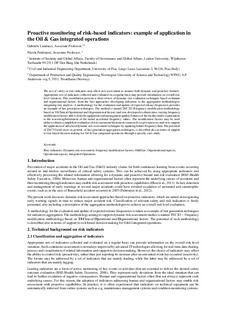| dc.contributor.author | Landucci, Gabriele | |
| dc.contributor.author | Paltrinieri, Nicola | |
| dc.date.accessioned | 2019-01-29T13:36:34Z | |
| dc.date.available | 2019-01-29T13:36:34Z | |
| dc.date.created | 2018-10-24T11:26:53Z | |
| dc.date.issued | 2018 | |
| dc.identifier.issn | 0307-0492 | |
| dc.identifier.uri | http://hdl.handle.net/11250/2582865 | |
| dc.description.abstract | The use of safety or risk indicators may allow risk assessment to assume both dynamic and proactive features. Appropriate sets of indicators collected and evaluated on a regular basis may provide information on overall risk level variation. This contribution presents a short review of dynamic risk evaluation techniques based on human and organizational factors, from the first approaches developing indicators to the aggregation methodologies integrating risk analysis. A methodology for the evaluation and update of expected release frequencies provides an example of last generation techniques. The method is named TEC2O (Frequency modification methodology based on TEChnical Operational and Organizational factors) and was developed to obtain time-varying frequency modification factors able to link the equipment and management quality features of the facility under examination to the worsening/betterment of the initial accidental frequency values. The modification factors may be used either to obtain a simplified evaluation of risk increment/decrement connected to a given process unit or to support the application of advanced dynamic risk assessment techniques by updating failure frequency data. The potential of TEC2O and, more in general, of last generation aggregation techniques, is described also in terms of support to risk-based decision making for Oil & Gas integrated operations through a specific case-study. | nb_NO |
| dc.language.iso | eng | nb_NO |
| dc.publisher | Institution of Chemical Engineers | nb_NO |
| dc.title | Proactive monitoring of risk-based indicators: Example of application in the Oil & Gas integrated operations | nb_NO |
| dc.title.alternative | Proactive monitoring of risk-based indicators: Example of application in the Oil & Gas integrated operations | nb_NO |
| dc.type | Journal article | nb_NO |
| dc.type | Peer reviewed | nb_NO |
| dc.description.version | acceptedVersion | nb_NO |
| dc.source.journal | Institution of Chemical Engineers Symposium Series | nb_NO |
| dc.identifier.cristin | 1623033 | |
| dc.description.localcode | © 2018. This is the authors' accepted and refereed manuscript to the article. | nb_NO |
| cristin.unitcode | 194,64,92,0 | |
| cristin.unitname | Institutt for maskinteknikk og produksjon | |
| cristin.ispublished | true | |
| cristin.fulltext | postprint | |
| cristin.qualitycode | 1 | |
